
Wine Culture and Information since 2002 - Volume 22
 Wine Culture and Information since 2002 - Volume 22 |
|
Issue 185, June 2019 |
Contents |
|
|
The Quality of Wine |
|
In the course of its history, wine has undeniably been a topic for which have been written – like to say – reams about it. This custom is evidently still alive and in constant ferment, as there are so many who write about this subject with unchanged passion and interest. Not only have been written reams about this subject in the past, today we also generate huge quantities of digital data and documents about the very same subject. We debate a lot about the origin of wine, both historical and territorial, as well as discussing its production, viticultural, environmental, ethical, moral and even philosophical practices. Everything, however, is always inevitably aimed at highlighting, enhancing, not least, denigrating and criticizing the quality of wine. Territories, grapes, wines, producers, wine and viticultural practices, methods of consumption and anything else related to wine are compared one to each other, always and in any case to set the definition of a reference and criterion of quality, often with the claim of absolute value. Defining quality, in any case, is not easy. In fact, there are many factors defining this characteristic, not only technical and objective, but also sentimental and cultural ones. Often, tradition is a factor used for the definition of quality, a very dear concept – for example – to those who remain convinced that “things of the past were however the best”. There is more, of course: the definition of quality is also determined by factors that could be classified as schools of thought, often characterized by rigid and unquestionable criteria, sometimes lacking concrete foundations and not only of scientific type. Then, undeniably, there is also the taste of those who drink wine and who define and use entirely subjective qualitative criteria, even though they can meet the favor of others, and therefore referable to a model of relative objectivity. To these factors are inevitably added other ones as well. The concept of quality – in any case – is constantly changing: what today is considered, in more or less objective terms, a quality wine, would have not been considered the same in the past and, very likely, it could not be in the future. It is enough to consider the qualitative concept of some centuries ago, as well as that of two thousand years ago, to understand how our modern quality concept is so far from it, even drastically changed. Very likely, in fact, the wines that today we consider of quality, in the past would have met neither the taste nor the generally accepted qualitative concept. The same is certainly true in the opposite sense, that is, wines considered excellent a few centuries ago would not meet our modern taste. Wines of ancient Greece, as well as those appreciated by the ancient Romans – according to what we were told by the authors of those times – had a basically sweet taste, while the modern and more appreciated ones, are definitely and evidently dry. Quality and taste – a concept valid for both wine and any food or drink – have changed over time according to the preferences, traditions and culture of men. This principle, of course, in addition to be influenced by historical variations, also changes according to geographical factors, as preferences, traditions and cultures are intimately linked to their own places of social expression. On this regard, for example, we can consider some eating habits of the countries of the world: foods considered, not only good, but also of quality in a certain place, could be exactly considered the opposite way elsewhere. Quality, therefore, is a criterion continually undergoing adaptations and redefinitions, often determined by technological development, in the case of wine, by the progress made in the viticultural and wine making context. This last aspect – in fact – must not be underestimated because it allows the creation of products, so to speak, unknown in the past, presumably of better quality and, possibly, healthier and safer. This allows, not least, the definition of an agreed quality criterion based on technical factors and which inevitably end up conditioning and educating consumers. Moreover, this also influences the choices of producers, who, in addition to the irreplaceable and fundamental role of their personal vision of wine production, tend to conform to the accepted and agreed quality model, in order to ensure themselves better commercial opportunities. A quality criterion such as this one, although widely agreed and accepted by consumers and producers, does not meet – of course – the favor and approval of all. There are many criticisms moved towards a wine-making model, so to speak, of a technical nature, as – according to some – it is too far from the “nature” of the wine (in case it has one) and, in some respects, sophisticated and altered by too many influences of human and chemical origin. Given that wine is always and in any case the result of the manipulation of grapes and vines – a process starting from the vineyard and ending up in the bottle – inevitably, carried out by the work of man, every principle of quality is however questionable according to any other reference criterion. In other words, quality is always relative. In this regard, it is interesting to note that certain characteristics considered as good in some quality models are actually considered as more or less serious faults in others. The definition of a quality model still remains indispensable and essential in any aspects about man's practical and emotional expressions. However, defining the concept of “good” and “bad” is an exercise in some respects of utopian nature – sometimes done with a certain intellectual arrogance – simply because it is conditioned by countless factors and not always universally acceptable or agreed. The need, in any case, for a quality reference is a fundamental, essential and inevitable prerequisite for understanding and defining wine. And it is certainly something going far beyond subjectivity, guaranteeing an objective reference that has a decidedly higher and more reliable value than the arrogance of few ones. Antonello Biancalana
|
||||
Contrasts of Cirò Rosso Classico and CaremaGaglioppo and Nebbiolo, grapes of different origins and organoleptic profiles, are compared in the glasses of this month with the wines of Cirò and Carema |
|
In a country like Italy, where there is a number of varieties and grapes like in no other place in the world, the territorial factor plays an obviously important role. This clearly occurs wherever grapes are grown and wine is produced, but wine production in Italy – thanks to the huge diversity and richness of grape varieties – gives origin to wines characterized by different nuances and organoleptic profiles even in case they are produced with the same grapes. It must in fact be considered in Italy, a country characterized by a territory with an extension of over 1000 kilometers, the climatic and soil differences give origin to countless viticultural conditions, and therefore enological, very different one from each other. To this we must also add human factors – essential to the production of any wine – and which have a fundamental influence on the interpretation of grapes and territories. These differences are unequivocally revealed during the tasting and the organoleptic evaluation, sometimes so evident that it makes one think even of different grapes despite they are actually the same. The differences become distant and evident with the varieties that are most common in Italy, such as Sangiovese – which also counts a large number of different clones – Barbera, Nebbiolo, Montepulciano, not least, the many international grapes found in every region. In many cases the differences become substantial even in wines produced in relatively close places, also in vineyards a few tens of meters apart. This is also the case of the two grapes protagonists of our tasting by contrast – Gaglioppo and Nebbiolo – typically cultivated, respectively, in Calabria and Piedmont. These two grapes, in fact, are very common in the respective regions and their wines express substantial differences depending on the origin. In this regard, we can think – for example – to Carema and Barolo with regard to Nebbiolo, or to Cirò Rosso and some Gaglioppo Calabria IGT (Indicazione Geografica Tipica, Indication of Geographic Origin).
|
|
Calabria, the region where Cirò Rosso Classico is produced in, has a very long and important wine history. The well-known and historical definition Enotria Tellus was in fact initially attributed by the ancient Greeks to the territory that today corresponds to Calabria. A very significant fact, proving that, when the ancient Greeks arrived in those lands, the cultivation of vine and the production of wine were already present and, not least, the quality was considered of high level. It would not otherwise be justified that the Greeks – at those times expert wine-growers and wine makers already – consecrated the ancient Calabria as the land of wine. Even the most famous red grape of Calabria – Gaglioppo – has a very long history and it was probably introduced in these lands at the time of the Magna Graecia, and has inextricably linked its name to the wines of Cirò, a town in the province of Crotone. The wines of Cirò – known at the times of ancient Greek as Krimisa, then Cremissa – seem to be already known and appreciated at the times of ancient Greeks and was the first wine of this region to obtain the recognition of Denominazione d'Origine Controllata (Denomination of Controlled Origin) in 1969. The red wines of this territory are mainly produced with Gaglioppo grape and, despite the minimum quota set by the disciplinary is 80%, producers tend to use it on its own. An obviously right and winning choice, as this noble Calabrian variety is capable of making wines of huge personality and good body, with excellent potential for aging over time. The production disciplinary recognizes only to the wines produced in the territory of Cirò and Cirò Marina the mention classico (classic) and this will be the wine we will choose for our tasting. Cirò Rosso is frequently vinified and aged in wooden barrels, a productive characteristic that tends, among the other things, to accentuate the spicy qualities of Gaglioppo as well as giving it greater roundness as well as making its tannins smoother.
|
||||
|
Carema is one of the many wines produced with Nebbiolo grape in Piedmont. It takes its name from the town of the same name in the northern part of the region, located on the border with Valle d'Aosta, in the Canavese area, in province of Turin. The cultivation of vines in these lands is certainly not as easy as elsewhere, here the territory is typically mountainous and it is not always easy to find places that are convenient for viticulture. Here vineyards are mainly cultivated with the pergola system in special terraces created in the mountain slopes. The production of Carema – area recognized as Denominazione d'Origine Controllata (Denomination of Controlled Origin) since 1967 – has been reduced over the last few years, also because of the not so easy viticultural conditions of the territory. However, it remains a wine full of charm and coming from an evocative place, yet another son of Bacchus produced with the king variety of Piedmont – Nebbiolo – which here is capable of expressing wine with greater finesse and elegance than in other lands. Despite its limited production, Carema wine is considered one of the most significant and representative ones of Piedmont, giving Nebbiolo a character of finesse and a very particular personality. Characterized by power and structure, Carema expresses a remarkable elegance, also thanks to the composition of the soil and the climatic conditions, so different – for example – from Langhe, the great land of Nebbiolo wines. The typical characteristics of this variety – rich in tannins and appreciable acidity – are however well expressed also in the wines of this territory. Carema provides for a minimum aging of 24 months, of which at least 12 in cask, a procedure that will favor the rounding of tannins and making the wine more balanced. As for the reserve style, the minimum aging time is 36 months, of which at least 24 in barrels. Finally, when talking about Carema, it should be noticed that here – as well as in neighboring Valle d'Aosta – Nebbiolo is known as Picotendro, or, in dialectal terms, Picotener or Picotendre.
|
Two very different grapes, two distant and different places in every aspect, both climatic and geographical, geological and geomorphological. The tasting by contrast of this month will in fact examine two emblematic wines of the respective regions – Calabria and Piedmont – produced with two grapes of primary enological interest: Gaglioppo and Nebbiolo. The wines we will pour in the glasses of this month are inevitably aged in cask, a choice primarily imposed by the production disciplinary of Carema which requires at least part of the wine making in wooden containers. In both cases, we will have to pay attention to the composition, as the production disciplinary of both Carema and Cirò Rosso Classico allow the use of other grapes besides, respectively, Nebbiolo and Gaglioppo. We will therefore pay attention the wines to be poured in the glasses are produced with the respective varieties on their own, a productive choice – it must be said – adopted by most of the producers. The wines belong to the last vintage available and aged in large barrels in order to limit, as far as possible, the excessive influence of wood. The wines are poured in tasting glasses at a temperature of 18 °C (65 °F). It is now the time to pour the wines into their respective glasses and start the tasting by contrast of this month, by assessing its appearance. The first wine we will examine is Cirò Rosso Classico. We tilt the glass over a white surface – a sheet of paper is enough – and we focus our attention at the base of the glass, where the mass of the wine is thicker. We observe a brilliant ruby red color and a moderate transparency: the object placed in contrast, in fact, is visible although not in a perfectly clear manner. The nuance of this wine, observed towards the edge of the glass, where the thickness becomes thin, confirms the ruby red color with a clear tendency to garnet. Let's now examine the appearance of Carema, produced with Nebbiolo. At the base of the glass, held tilted above the white surface, it reveals a brilliant ruby red color and a moderate transparency, evidently more transparent than Cirò Rosso Classico. The nuance of Carema shows a ruby red color tending to garnet. Cirò Rosso Classico and Carema – therefore Gaglioppo and Nebbiolo – express very distinct and different olfactory profiles to the nose. In both cases, the sensations perceived directly recall fruits with red and dark flesh, as well as flowers, however the respective intensity and composition makes the two wines clearly different. To this must be added the influence of the vinification in wood – mandatory for Carema, optional for Cirò Rosso Classico, however very frequent – with the result of two olfactory profiles with noticeable differences to the nose. Unlike Nebbiolo, Gaglioppo tends to have a more spicy profile and in which black pepper is often perceived. The aromas of fruits typically found in Gaglioppo are expressed with black cherry, plum, strawberry and blueberry, while, as for flowers, cyclamen and rose are the most common ones. A very different profile than Nebbiolo which typically expresses aromas of plum, cherry and raspberry, whereas for the sensations of flowers, violet and rose are the most frequent ones. Let's continue our tasting by contrast and proceed with the evaluation of the olfactory profiles of Cirò Rosso Classico and Carema, starting with the Calabrian wine. By holding the glass in vertical position and without swirling, do the first smell in order to perceive opening aromas, that is the initial sensations emerging from the glass. The nose reveals intense and clean aromas of black cherry, plum and strawberry as well as a pleasant sensation in which can be recognized rose. After having swirled the glass, the second smell gives aromas of blueberry, cyclamen and, in addition to the aromas given by the aging in wood, can be perceived the typical touch of black pepper. Let's now pass to the evaluation of Carema, starting – just like in the previous wine – from the opening aromas. From the glass are perceived intense and clean aromas of cherry, plum, raspberry as well as violet and rose. After having swirled the glass, the olfactory profile of Carema is completed with the tertiary sensations given by wood, including chocolate and tobacco, as well as a pleasing balsamic sensation in which can be recognized menthol. Let's now pass to the evaluation of the gustatory profiles of the two wines, starting, like in the previous phases, from Cirò Rosso Classico. The first gustatory aspect that we will examine is the attack, that is the initial sensations the wine expresses in the mouth. Let's take a sip of Cirò Rosso Classico: in the mouth we perceive the good structure, a well perceptible astringency – sometimes with moderately rough tannins – and perfectly balanced both by the roundness given by the aging in wood and by alcohol. This wine gives to the mouth flavors of black cherry, plum and strawberry, confirming the good correspondence to the nose. Let's now proceed to the evaluation of Carema and take a sip of this wine in order to evaluate its opening. In the mouth it is immediately perceived the robust structure and the power of tannins, which combine to the crispness of acidity, decidedly stronger than Cirò Rosso Classico. Also in this case the aging in wood and alcohol give the wine the right balance and in the mouth are perceived flavors of cherry, plum and raspberry. The fourth and last phase of our tasting is about the evaluation of the final sensations the two wines leave in the mouth and, in particular, the taste-olfactory persistence, that is the amount of time during which the perception of taste-olfactory qualities are expressed. The finish of Cirò Rosso Classico is clearly persistent: in the mouth we still perceive the good structure and astringency which is combined with the roundness and pseudo-burning sensations of alcohol. Flavors of black cherry, plum and strawberry can be perceived in the mouth for many seconds. The finish of Carema is characterized by good persistence and well expressed by the typical qualities of Nebbiolo. In fact, the power of structure and tannins is clearly perceived, with a good balance in which can be perceived the elegance of crispness given by acidity, in addition to the warm sensation of alcohol. In the mouth, we can also continue perceiving the flavors of cherry, plum and raspberry. Let's conclude our tasting by contrast by analyzing the two wines and taking again another sip of both: the sensorial differences are evident in every aspect of the organoleptic qualities.
|
||||||||
Wines of the Month |
|
|
|
Score legend Prices are to be considered as indicative. Prices may vary according to the country or the shop where wines are bought |
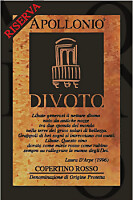
|
|
Copertino Rosso Riserva Divoto 2010 |
|
| Apollonio (Apulia, Italy) | |
 Negroamaro (70%), Montepulciano (30%) Negroamaro (70%), Montepulciano (30%) | |
| Price: € 32.00 | Score: |
 Intense ruby red and nuances of garnet red, little transparency. Intense ruby red and nuances of garnet red, little transparency. Intense, clean, pleasing, refined and elegant, starts with hints of
prune, blackberry and dried violet followed by aromas of black cherry,
blueberry jam, cocoa, tobacco, clove, black pepper, licorice, leather,
menthol and vanilla. Intense, clean, pleasing, refined and elegant, starts with hints of
prune, blackberry and dried violet followed by aromas of black cherry,
blueberry jam, cocoa, tobacco, clove, black pepper, licorice, leather,
menthol and vanilla.
 Properly tannic attack and however balanced by alcohol, good body,
intense flavors, pleasing roundness. Properly tannic attack and however balanced by alcohol, good body,
intense flavors, pleasing roundness.
 Persistent finish with flavors of prune, blackberry and black cherry. Persistent finish with flavors of prune, blackberry and black cherry. 24 months in barrique, 6 months in cask, 12 months in bottle. 24 months in barrique, 6 months in cask, 12 months in bottle. |
|
 Broiled meat and barbecue, Roasted meat, Stewed and braised meat with mushrooms, Hard cheese Broiled meat and barbecue, Roasted meat, Stewed and braised meat with mushrooms, Hard cheese |
|

|
|
Vigna Vitrilli Grande 1997 |
|
| Apollonio (Apulia, Italy) | |
 Primitivo (50%), Aleatico (30%), Negroamaro (20%) Primitivo (50%), Aleatico (30%), Negroamaro (20%) | |
| Price: € 80.00 | Score: |
 Intense ruby red and nuances of garnet red, little transparency. Intense ruby red and nuances of garnet red, little transparency. Intense, clean, pleasing, refined and elegant, starts with hints of
plum jam, black cherry jam and blueberry jam followed by aromas of dried
violet, dried fig, tobacco, cocoa, mace, tar, clove, licorice, vanilla,
leather and menthol. Intense, clean, pleasing, refined and elegant, starts with hints of
plum jam, black cherry jam and blueberry jam followed by aromas of dried
violet, dried fig, tobacco, cocoa, mace, tar, clove, licorice, vanilla,
leather and menthol.
 Properly tannic attack and however balanced by alcohol, full body,
intense flavors, pleasing roundness. Properly tannic attack and however balanced by alcohol, full body,
intense flavors, pleasing roundness.
 Persistent finish with flavors of plum jam, black cherry jam and
blueberry jam. Persistent finish with flavors of plum jam, black cherry jam and
blueberry jam.
 72 months in barrique, 6 months in cask, 12 months in bottle. 72 months in barrique, 6 months in cask, 12 months in bottle. |
|
 Game, Stewed and braised meat with mushrooms, Hard cheese Game, Stewed and braised meat with mushrooms, Hard cheese |
|
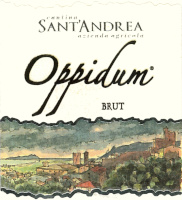
|
|
Oppidum Brut 2017 |
|
| Sant'Andrea (Latium, Italy) | |
 Moscato di Terracina Moscato di Terracina | |
| Price: € 7.50 | Score: |
 Intense golden yellow and nuances of golden yellow, very transparent,
fine and persistent perlage. Intense golden yellow and nuances of golden yellow, very transparent,
fine and persistent perlage.
 Intense, clean, pleasing and refined, starts with hints of grape,
apricot and white rose followed by aromas of banana, apple, peach, sage and
lavender. Intense, clean, pleasing and refined, starts with hints of grape,
apricot and white rose followed by aromas of banana, apple, peach, sage and
lavender.
 Crisp and effervescent attack, however balanced by alcohol, good body,
intense flavors, agreeable. Crisp and effervescent attack, however balanced by alcohol, good body,
intense flavors, agreeable.
 Persistent finish with flavors of grape, apricot and apple. Persistent finish with flavors of grape, apricot and apple. Produced with the Charmat method. Produced with the Charmat method. |
|
 Crustacean appetizers, Risotto with fish and crustaceans, Fried fish Crustacean appetizers, Risotto with fish and crustaceans, Fried fish |
|
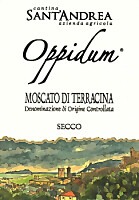
|
|
Moscato di Terracina Secco Oppidum 2018 |
|
| Sant'Andrea (Latium, Italy) | |
 Moscato di Terracina Moscato di Terracina | |
| Price: € 7.30 | Score: |
 Intense golden yellow and nuances of golden yellow, very transparent. Intense golden yellow and nuances of golden yellow, very transparent. Intense, clean, pleasing and refined, starts with hints of grape, peach
and citrus fruits followed by aromas of banana, white rose, apricot, apple,
pear, lychee and sage. Intense, clean, pleasing and refined, starts with hints of grape, peach
and citrus fruits followed by aromas of banana, white rose, apricot, apple,
pear, lychee and sage.
 Crisp attack and however balanced by alcohol, good body, intense
flavors, agreeable. Crisp attack and however balanced by alcohol, good body, intense
flavors, agreeable.
 Persistent finish with flavors of grape, peach and banana. Persistent finish with flavors of grape, peach and banana. Aged in steel tanks. Aged in steel tanks. |
|
 Pasta and risotto with fish and crustaceans, Broiled fish and crustaceans, Dairy products Pasta and risotto with fish and crustaceans, Broiled fish and crustaceans, Dairy products |
|
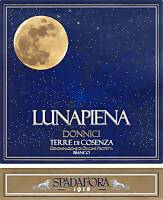
|
|
Terre di Cosenza Donnici Lunapiena Oro 2018 |
|
| Spadafora 1915 (Calabria, Italy) | |
 Greco Bianco (70%), Montonico (20%), Malvasia Bianca (10%) Greco Bianco (70%), Montonico (20%), Malvasia Bianca (10%) | |
| Price: € 16.00 | Score: |
 Pale straw yellow and nuances of greenish yellow, very transparent. Pale straw yellow and nuances of greenish yellow, very transparent. Intense, clean, pleasing and refined, starts with hints of apple,
pineapple and bergamot followed by aromas of peach, pear, plum, hawthorn,
jasmine, broom, mineral and hints of vanilla. Intense, clean, pleasing and refined, starts with hints of apple,
pineapple and bergamot followed by aromas of peach, pear, plum, hawthorn,
jasmine, broom, mineral and hints of vanilla.
 Crisp attack and however balanced by alcohol, good body, intense
flavors, agreeable. Crisp attack and however balanced by alcohol, good body, intense
flavors, agreeable.
 Persistent finish with flavors of apple, pineapple and peach. Persistent finish with flavors of apple, pineapple and peach. 4 months in steel tanks, 6 months in barrique, 3 months in bottle. 4 months in steel tanks, 6 months in barrique, 3 months in bottle. |
|
 Fried fish, Pasta with fish, Stewed fish, Sauteed white meat Fried fish, Pasta with fish, Stewed fish, Sauteed white meat |
|
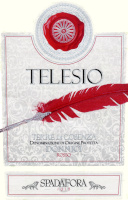
|
|
Terre di Cosenza Donnici Telesio 2016 |
|
| Spadafora 1915 (Calabria, Italy) | |
 Carne alla griglia, Carne arrosto, Stufati di carne con funghi, Formaggi stagionati Carne alla griglia, Carne arrosto, Stufati di carne con funghi, Formaggi stagionati | |
| Price: € 02.00 | Score: |
 Intense ruby red and nuances of garnet red, little transparency. Intense ruby red and nuances of garnet red, little transparency. Intense, clean, pleasing and refined, starts with hints of black
cherry, plum and raspberry followed by aromas of violet, blueberry,
geranium, tobacco, carob and vanilla. Intense, clean, pleasing and refined, starts with hints of black
cherry, plum and raspberry followed by aromas of violet, blueberry,
geranium, tobacco, carob and vanilla.
 Properly tannic attack and however balanced by alcohol, good body,
intense flavors, agreeable. Properly tannic attack and however balanced by alcohol, good body,
intense flavors, agreeable.
 Persistent finish with flavors of black cherry, plum and raspberry. Persistent finish with flavors of black cherry, plum and raspberry. 6 months in steel tanks, 12 months in barrique, 6 months in bottle. 6 months in steel tanks, 12 months in barrique, 6 months in bottle. |
|
 Broiled meat and barbecue, Roasted meat, Stewed meat with mushrooms, Hard cheese Broiled meat and barbecue, Roasted meat, Stewed meat with mushrooms, Hard cheese |
|
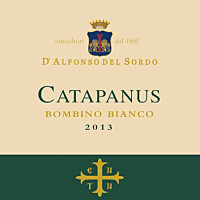
|
|
Catapanus 2018 |
|
| D'Alfonso del Sordo (Apulia, Italy) | |
 Bombino Bianco Bombino Bianco | |
| Price: € 9.00 | Score: |
 Brilliant straw yellow and nuances of straw yellow, very transparent. Brilliant straw yellow and nuances of straw yellow, very transparent. Intense, clean, pleasing and refined, starts with hints of apple, pear
and hawthorn followed by aromas of banana, citrus fruits, pineapple and
plum. Intense, clean, pleasing and refined, starts with hints of apple, pear
and hawthorn followed by aromas of banana, citrus fruits, pineapple and
plum.
 Crisp attack and however balanced by alcohol, good body, intense
flavors, agreeable. Crisp attack and however balanced by alcohol, good body, intense
flavors, agreeable.
 Persistent finish with flavors of apple, pear and pineapple. Persistent finish with flavors of apple, pear and pineapple. Aged in steel tanks. Aged in steel tanks. |
|
 Fish and crustacean appetizers, Pasta and risotto with vegetables, Eggs, Dairy products Fish and crustacean appetizers, Pasta and risotto with vegetables, Eggs, Dairy products |
|
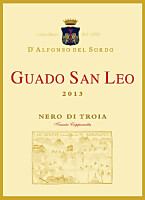
|
|
Guado San Leo 2013 |
|
| D'Alfonso del Sordo (Apulia, Italy) | |
 Uva di Troia Uva di Troia | |
| Price: € 20.00 | Score: |
 Intense ruby red and nuances of garnet red, little transparency. Intense ruby red and nuances of garnet red, little transparency. Intense, clean, pleasing and refined, starts with hints of black
cherry, plum and blueberry followed by aromas of violet, raspberry, black
currant, tobacco, carob, mace and vanilla. Intense, clean, pleasing and refined, starts with hints of black
cherry, plum and blueberry followed by aromas of violet, raspberry, black
currant, tobacco, carob, mace and vanilla.
 Tannic attack and however balanced by alcohol, good body, intense
flavors, agreeable. Tannic attack and however balanced by alcohol, good body, intense
flavors, agreeable.
 Persistent finish with flavors of black cherry, plum and blueberry. Persistent finish with flavors of black cherry, plum and blueberry. 12 months in barrique. 12 months in barrique. |
|
 Broiled meat and barbecue, Roasted meat, Stewed meat with mushrooms, Hard cheese Broiled meat and barbecue, Roasted meat, Stewed meat with mushrooms, Hard cheese |
|
News |
|
In this section are published news and information about events concerning the world of wine and food. Whoever is interested in publishing this kind of information can send us a mail to our address.
|
AquavitaeReview of Grappa, Distillates and Brandy |
|
|
||||||||||||
Wine Guide ParadeMarch 2019
|
| |||||||
Privacy Policy | |||||||


| Copyright © 2002-2024 Antonello Biancalana, DiWineTaste - All rights reserved |
| All rights reserved under international copyright conventions. No part of this publication and of this WEB site may be
reproduced or utilized in any form or by any means, electronic or mechanical, without permission in writing from DiWineTaste. |